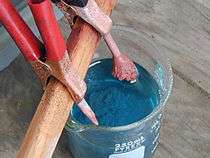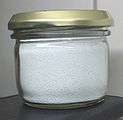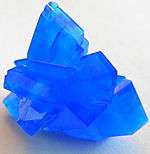Copper(II) sulfate
Copper(II) sulfate, also known as copper sulphate, are the inorganic compounds with the chemical formula CuSO4(H2O)x, where x can range from 0 to 5. The pentahydrate (x = 5) is the most common form. Older names for this compound include blue vitriol, bluestone,[9] vitriol of copper,[10] and Roman vitriol.[11]
| |||
| Names | |||
|---|---|---|---|
| IUPAC name
Copper(II) sulfate | |||
| Other names
Cupric sulphate Blue vitriol (pentahydrate) Bluestone (pentahydrate) Bonattite (trihydrate mineral) Boothite (heptahydrate mineral) Chalcanthite (pentahydrate mineral) Chalcocyanite (mineral) Copper Sulphate pentahydrate | |||
| Identifiers | |||
| |||
3D model (JSmol) |
|||
| ChEBI | |||
| ChEMBL | |||
| ChemSpider | |||
| ECHA InfoCard | 100.028.952 | ||
| EC Number |
| ||
| E number | E519 (acidity regulators, ...) | ||
| KEGG | |||
PubChem CID |
|||
| RTECS number |
| ||
| UNII | |||
CompTox Dashboard (EPA) |
|||
| |||
| |||
| Properties | |||
| CuSO4 (anhydrous) CuSO4·5H2O (pentahydrate) | |||
| Molar mass | 159.609 g/mol (anhydrous)[1] 249.685 g/mol (pentahydrate)[1] | ||
| Appearance | gray-white (anhydrous) blue (pentahydrate) | ||
| Density | 3.60 g/cm3 (anhydrous)[1] 2.286 g/cm3 (pentahydrate)[1] | ||
| Melting point | 110 °C (230 °F; 383 K) decomposes (·5H2O)[1] if pentahydrate <560 °C decomposes[1] if anhydrous | ||
| Boiling point | decomposes | ||
| 1.055 molal (10 °C) 1.26 molal (20 °C) 1.502 molal (30 °C)[2] | |||
| Solubility | anhydrous insoluble in ethanol[1] pentahydrate soluble in methanol[1] 10.4 g/L (18 °C) insoluble in ethanol, insoluble in acetone | ||
| +1330·10−6 cm3/mol | |||
Refractive index (nD) |
1.724–1.739 (anhydrous)[3] 1.514–1.544 (pentahydrate)[4] | ||
| Structure | |||
| Orthorhombic (anhydrous, chalcocyanite), space group Pnma, oP24, a = 0.839 nm, b = 0.669 nm, c = 0.483 nm.[5] Triclinic (pentahydrate), space group P1, aP22, a = 0.5986 nm, b = 0.6141 nm, c = 1.0736 nm, α = 77.333°, β = 82.267°, γ = 72.567°[6] | |||
| Thermochemistry | |||
Std molar entropy (S |
5 J K−1 mol−1 | ||
Std enthalpy of formation (ΔfH⦵298) |
−769.98 kJ/mol | ||
| Pharmacology | |||
| V03AB20 (WHO) | |||
| Hazards | |||
| Safety data sheet | anhydrous pentahydrate | ||
| GHS pictograms |   | ||
| NFPA 704 (fire diamond) | |||
| Flash point | Non-flammable | ||
| Lethal dose or concentration (LD, LC): | |||
LD50 (median dose) |
300 mg/kg (oral, rat)[7]
87 mg/kg (oral, mouse) | ||
| NIOSH (US health exposure limits): | |||
PEL (Permissible) |
TWA 1 mg/m3 (as Cu)[8] | ||
REL (Recommended) |
TWA 1 mg/m3 (as Cu)[8] | ||
IDLH (Immediate danger) |
TWA 100 mg/m3 (as Cu)[8] | ||
| Related compounds | |||
Other cations |
Iron(II) sulfate Manganese(II) sulfate Nickel(II) sulfate Zinc sulfate | ||
Except where otherwise noted, data are given for materials in their standard state (at 25 °C [77 °F], 100 kPa). | |||
| Infobox references | |||
The pentahydrate (CuSO4·5H2O), the most commonly encountered salt, is bright blue. It exothermically dissolves in water to give the aquo complex [Cu(H2O)6]2+, which has octahedral molecular geometry. The structure of the solid pentahydrate reveals a polymeric structure wherein copper is again octahedral but bound to four water ligands. The Cu(II)(H2O)4 centers are interconnected by sulfate anions to form chains.[12] Anhydrous copper sulfate is a light grey powder.
Preparation and occurrence

Copper sulfate is produced industrially by treating copper metal with hot concentrated sulfuric acid or its oxides with dilute sulfuric acid. For laboratory use, copper sulfate is usually purchased. Copper sulfate can also be produced by slowly leaching low grade copper ore in air; bacteria may be used to hasten the process.[13]
Commercial copper sulfate is usually about 98% pure copper sulfate, and may contain traces of water. Anhydrous Copper sulfate is 39.81 percent copper and 60.19 percent sulfate by mass, and in its blue, hydrous form, it is 25.47% copper, 38.47% sulfate (12.82% sulfur) and 36.06% water by mass. Four types of crystal size are provided based on its usage: large crystals (10–40 mm), small crystals (2–10 mm), snow crystals (less than 2 mm), and windswept powder (less than 0.15 mm).[13]
Chemical properties
Copper(II) sulfate pentahydrate decomposes before melting. It loses two water molecules upon heating at 63 °C (145 °F), followed by two more at 109 °C (228 °F) and the final water molecule at 200 °C (392 °F).[14][15] Dehydration proceeds by decomposition of the tetraaquacopper(2+) moiety, two opposing aqua groups are lost to give a diaquacopper(2+) moiety. The second dehydration step occurs when the final two aqua groups are lost. Complete dehydration occurs when the final unbound water molecule is lost. At 650 °C (1,202 °F), copper(II) sulfate decomposes into copper(II) oxide (CuO) and sulfur trioxide (SO3).
Copper sulfate reacts with concentrated hydrochloric acid to give tetrachlorocuprate(II):
- Cu2+ + 4 Cl− → CuCl2−
4
Chemistry education
Copper sulfate is commonly included in children's chemistry sets. It is often used to grow crystals in schools and in copper plating experiments, despite its toxicity. Copper sulfate is often used to demonstrate an exothermic reaction, in which steel wool or magnesium ribbon is placed in an aqueous solution of CuSO4. It is used to demonstrate the principle of mineral hydration. The pentahydrate form, which is blue, is heated, turning the copper sulfate into the anhydrous form which is white, while the water that was present in the pentahydrate form evaporates. When water is then added to the anhydrous compound, it turns back into the pentahydrate form, regaining its blue color, and is known as blue vitriol.[16] Copper(II) sulfate pentahydrate can easily be produced by crystallization from solution as copper(II) sulfate, which is hygroscopic.
In an illustration of a "single metal replacement reaction", iron is submerged in a solution of copper sulfate. Iron reacts producing iron(II) sulfate and copper precipitates.
- Fe + CuSO4 → FeSO4 + Cu
In high school and general chemistry education, copper sulfate is used as electrolyte for galvanic cells, usually as a cathode solution. For example, in a zinc/copper cell, copper ion in copper sulfate solution absorbs electron from zinc and forms metallic copper.[17]
- Cu2+ + 2e− → Cu (cathode) E°cell=0.34V
Uses
As a fungicide and herbicide
Copper sulfate pentahydrate is used as a fungicide.[18] However, some fungi are capable of adapting to elevated levels of copper ions.[19]
Bordeaux mixture, a suspension of copper(II) sulfate (CuSO4) and calcium hydroxide (Ca(OH)2), is used to control fungus on grapes, melons, and other berries.[20] It is produced by mixing a water solution of copper sulfate and a suspension of slaked lime.
Cheshunt compound, a commercial mixture of copper sulfate and ammonium carbonate (discontinued), is used in horticulture to prevent damping off in seedlings.[21] As a non-agricultural herbicide, is it used to control invasive aquatic plants and the roots of plants situated near water pipes. It is used in swimming pools as an algicide. A dilute solution of copper sulfate is used to treat aquarium fishes for parasitic infections,[22] and is also used to remove snails from aquariums. Copper ions are highly toxic to fish, however. Most species of algae can be controlled with very low concentrations of copper sulfate.
Analytical reagent
Several chemical tests utilize copper sulfate. It is used in Fehling's solution and Benedict's solution to test for reducing sugars, which reduce the soluble blue copper(II) sulfate to insoluble red copper(I) oxide. Copper(II) sulfate is also used in the Biuret reagent to test for proteins.
Copper sulfate is used to test blood for anemia. The blood is tested by dropping it into a solution of copper sulfate of known specific gravity – blood which contains sufficient hemoglobin sinks rapidly due to its density, whereas blood which does not sink or sinks slowly has insufficient amount of hemoglobin.[23]
In a flame test, its copper ions emit a deep green light, a much deeper green than the flame test for barium.
Organic synthesis
Copper sulfate is employed at a limited level in organic synthesis.[24] The anhydrous salt is used as a dehydrating agent for forming and manipulating acetal groups.[25] The hydrated salt can be intimately mingled with potassium permanganate to give an oxidant for the conversion of primary alcohols.[26]
Niche uses
Copper(II) sulfate has attracted many niche applications over the centuries. In industry copper sulfate has multiple applications. In printing it is an additive to book binding pastes and glues to protect paper from insect bites; in building it is used as an additive to concrete to provide water resistance and disinfectant qualities. Copper sulfate can be used as a coloring ingredient in artworks, especially glasses and potteries.[27] Copper sulfate is also used in firework manufacture as a blue coloring agent, but it is not safe to mix copper sulfate with chlorates when mixing firework powders.[28]
Copper sulfate was once used to kill bromeliads, which serve as mosquito breeding sites.[29] Copper sulfate is used as a molluscicide to treat bilharzia in tropical countries.[27]
Art
In 2008, the artist Roger Hiorns filled an abandoned waterproofed council flat in London with 75,000 liters of copper sulfate solution. The solution was left to crystallize for several weeks before the flat was drained, leaving crystal-covered walls, floors and ceilings. The work is titled Seizure.[30] Since 2011, it has been on exhibition at the Yorkshire Sculpture Park.[31]
Etching
Copper sulfate is used to etch zinc or copper plates for intaglio printmaking.[32][33] It is also used to etch designs into copper for jewelry, such as for Champlevé.[34]
Dyeing
Copper sulfate can be used as a mordant in vegetable dyeing. It often highlights the green tints of the specific dyes.
Electronics
An aqueous solution of copper sulfate is often used as the resistive element in liquid resistors.
Medical and public health issues
Copper sulfate was used in the past as an emetic.[35] It is now considered too toxic for this use.[36] It is still listed as an antidote in the World Health Organization's Anatomical Therapeutic Chemical Classification System.[37]
Other form of copper sulfates
Anhydrous copper(II) sulfate is a white solid. It can be produced by dehydration of the normally available pentahydrate copper sulfate. In nature, it found as the very rare mineral known as chalcocyanite.[38] The pentahydrate also occurs in nature as chalcanthite. Two other copper sulfates comprise the remaining of these rare minerals: bonattite (trihydrate)[39] and boothite (heptahydrate).[40]
- Anhydrous copper(II) sulfate
 Anhydrous CuSO4.
Anhydrous CuSO4.-sulfate-3D-vdW.png) Space-filling model anhydrous CuSO4.
Space-filling model anhydrous CuSO4. The rare (bluish) mineral boothite (CuSO4·7H2O)
The rare (bluish) mineral boothite (CuSO4·7H2O)
Toxicological effects
Copper sulfate is an irritant.[41] The usual routes by which humans can receive toxic exposure to copper sulfate are through eye or skin contact, as well as by inhaling powders and dusts.[42] Skin contact may result in itching or eczema.[43] Eye contact with copper sulfate can cause conjunctivitis, inflammation of the eyelid lining, ulceration, and clouding of the cornea.[44]
Upon oral exposure, copper sulfate is moderately toxic.[42] According to studies, the lowest dose of copper sulfate that had a toxic effect on humans is 11 mg/kg.[45] Because of its irritating effect on the gastrointestinal tract, vomiting is automatically initiated in case of the ingestion of copper sulfate. However, if copper sulfate is retained in the stomach, the symptoms can be severe. After 1–12 grams of copper sulfate are swallowed, such poisoning signs may occur as a metallic taste in the mouth, burning pain in the chest, nausea, diarrhea, vomiting, headache, discontinued urination, which leads to yellowing of the skin. In cases of copper sulfate poisoning, injury to the brain, stomach, liver, or kidneys may also occur.[44]
Environmental toxicity
Copper sulfate is highly soluble in water and therefore is easy to distribute in the environment. Copper in the soil may be from industry, motor vehicle, and architectural materials.[46] According to studies, copper sulfate exists mainly in the surface soil and tends to bind organic matter. The more acidic the soil is, the less binding occurs.
See also
References
- Haynes, p. 4.62
- Haynes, p. 5.199
- Anthony, John W.; Bideaux, Richard A.; Bladh, Kenneth W.; Nichols, Monte C., eds. (2003). "Chalcocyanite" (PDF). Handbook of Mineralogy. V. Borates, Carbonates, Sulfates. Chantilly, VA, US: Mineralogical Society of America. ISBN 978-0962209741.
- Haynes, p. 10.240
- Kokkoros, P. A.; Rentzeperis, P. J. (1958). "The crystal structure of the anhydrous sulphates of copper and zinc". Acta Crystallographica. 11 (5): 361–364. doi:10.1107/S0365110X58000955.
- Bacon, G. E.; Titterton, D. H. (1975). "Neutron-diffraction studies of CuSO4 · 5H2O and CuSO4 · 5D2O". Z. Kristallogr. 141 (5–6): 330–341. doi:10.1524/zkri.1975.141.5-6.330.
- Cupric sulfate. US National Institutes of Health
- NIOSH Pocket Guide to Chemical Hazards. "#0150". National Institute for Occupational Safety and Health (NIOSH).
- "Copper (II) sulfate MSDS". Oxford University. Archived from the original on 2007-10-11. Retrieved 2007-12-31.
- Antoine-François de Fourcroy, tr. by Robert Heron (1796) "Elements of Chemistry, and Natural History: To which is Prefixed the Philosophy of Chemistry". J. Murray and others, Edinburgh. Page 348.
- Oxford University Press, "Roman vitriol", Oxford Living Dictionaries. Accessed on 2016-11-13
- Ting, V. P.; Henry, P. F.; Schmidtmann, M.; Wilson, C. C.; Weller, M. T. (2009). "In situ neutron powder diffraction and structure determination in controlled humidities". Chem. Commun. 2009 (48): 7527–7529. doi:10.1039/B918702B. PMID 20024268.
- "Uses of Copper Compounds: Copper Sulphate". copper.org. Copper Development Association Inc. Retrieved 10 May 2015.
- Andrew Knox Galwey; Michael E. Brown (1999). Thermal decomposition of ionic solids. Elsevier. pp. 228–229. ISBN 978-0-444-82437-0.
- Wiberg, Egon; Nils Wiberg; Arnold Frederick Holleman (2001). Inorganic chemistry. Academic Press. p. 1263. ISBN 978-0-12-352651-9.
- "Process for the preparation of stable copper(II) sulfate monohydrate applicable as trace element additive in animal fodders". Retrieved 2009-07-07.
- Zumdahl, Steven; DeCoste, Donald (2013). Chemical Principles. Cengage Learning. pp. 506–507. ISBN 978-1-285-13370-6.
- Johnson, George Fiske (1935). "The Early History of Copper Fungicides". Agricultural History. 9 (2): 67–79. JSTOR 3739659.
- Parry, K. E.; Wood, R. K. S. (1958). "The adaption of fungi to fungicides: Adaption to copper and mercury salts". Annals of Applied Biology. 46 (3): 446–456. doi:10.1111/j.1744-7348.1958.tb02225.x.
- Martin, Hubert (1933). "Uses of Copper Compounds: Copper Sulfate's Role in Agriculture". Annals of Applied Biology. 20 (2): 342–363. doi:10.1111/j.1744-7348.1933.tb07770.x. Retrieved 2007-12-31.
- Coutts, J, Edwards, A, Osborn, A, & Preston, GH, The Complete Book of Gardening, p. 533, Ward Lock, London (1954)
- "All About Copper Sulfate". National Fish Pharmaceuticals. Retrieved 2007-12-31.
- Estridge, Barbara H.; Anna P. Reynolds; Norma J. Walters (2000). Basic Medical Laboratory Techniques. Thomson Delmar Learning. p. 166. ISBN 978-0-7668-1206-2.
- Hoffman, R. V. (2001). "Copper(II) Sulfate". Copper(II) Sulfate, in Encyclopedia of Reagents for Organic Synthesis. John Wiley & Sons. doi:10.1002/047084289X.rc247. ISBN 978-0471936237.
- Philip J. Kocienski (2005). Protecting Groups. Thieme. p. 58. ISBN 978-1-58890-376-1.
- Jefford, C. W.; Li, Y.; Wang, Y. "A Selective, Heterogeneous Oxidation using a Mixture of Potassium Permanganate and Cupric Sulfate: (3aS,7aR)-Hexahydro-(3S,6R)-Dimethyl-2(3H)-Benzofuranone". Organic Syntheses.; Collective Volume, 9, p. 462
- Copper Development Association. "Uses of Copper Compounds: Table A - Uses of Copper Sulphate". copper. Copper Development Association Inc. Retrieved 12 May 2015.
- Partin, Lee. "The Blues: Part 2". skylighter. Skylighter.Inc. Archived from the original on 21 December 2010. Retrieved 12 May 2015.
- Despommier; Gwadz; Hotez; Knirsch (June 2005). Parasitic Disease (5 ed.). NY: Apple Tree Production L.L.C. pp. Section 4.2. ISBN 978-0970002778. Retrieved 12 May 2015.
- "Seizure homepage". Artangel.org.uk. Retrieved 2009-09-21.
- "Roger Hiorns: Seizure". Yorkshire Sculpture Park. Archived from the original on 2015-02-22. Retrieved 2015-02-22.
- greenart.info, Bordeau etch, 2009-01-18, retrieved 2011-06-02.
- ndiprintmaking.ca, The Chemistry of using Copper Sulfate Mordant, 2009-04-12, retrieved 2011-06-02.
- http://mordent.com/etch-howto/, How to Electrolytically etch in copper, brass, steel, nickel silver or silver, retrieved 2015-05-2015.
- Holtzmann, N. A.; Haslam, R. H. (July 1968). "Elevation of serum copper following copper sulfate as an emetic". Pediatrics. 42 (1): 189–93. PMID 4385403.
- Olson, Kent C. (2004). Poisoning & drug overdose. New York: Lange Medical Mooks/McGraw-Hill. p. 175. ISBN 978-0-8385-8172-8.
- V03AB20 (WHO)
- Chalcocyanite on Mindat
- Bonattite on Mindat
- Boothite on Mindat
- Windholz, M., ed. 1983. The Merck Index. Tenth edition. Rahway, NJ: Merck and Company.
- Guidance for reregistration of pesticide products containing copper sulfate. Fact sheet no. 100., Washington, DC: U.S. Environmental Protection Agency, Office of Pesticide Programs, 1986
- TOXNET. 1975–1986. National library of medicine's toxicology data network. Hazardous Substances Data Bank (HSDB). Public Health Service. National Institute of Health, U.S. Department of Health and Human Services. Bethesda, MD: NLM.
- Clayton, G. D. and F. E. Clayton, eds. 1981. Patty's industrial hygiene and toxicology. Third edition. Vol. 2, Part 6 Toxicology. NY: John Wiley and Sons. ISBN 0-471-01280-7
- National Institute for Occupational Safety and Health (NIOSH). 1981–1986. Registry of toxic effects of chemical substances (RTECS). Cincinnati, OH: NIOSH.
- United State Environment Protection Agency. "Reregistration Eligibility Decision (RED) for Coppers" (PDF). www.epa.org. United State Environment Protection Agency. Retrieved 12 May 2015.
Bibliography
- Haynes, William M., ed. (2011). CRC Handbook of Chemistry and Physics (92nd ed.). Boca Raton, FL: CRC Press. ISBN 978-1439855119.
External links
| Wikimedia Commons has media related to Copper(II) sulfate. |
- International Chemical Safety Card 0751
- International Chemical Safety Card 1416
- National Pollutant Inventory – Copper and compounds fact sheet
.jpg)

